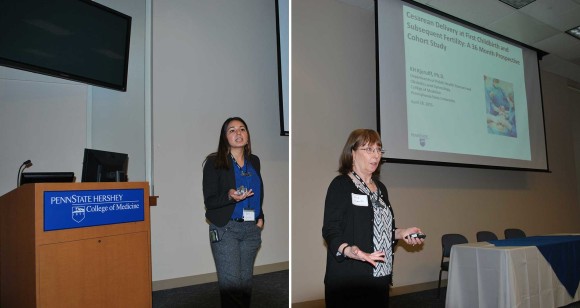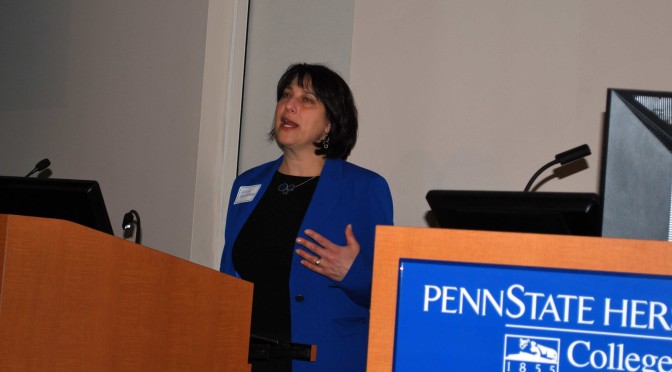In 1977 the U.S. Food and Drug Administration banned women “of child-bearing potential” from participating in clinical trials. This was in part due to thousands of children worldwide being born with missing and malformed limbs after their mothers had taken thalidomide — often prescribed in the 1950s for nausea and as a sleep aid.
A decade and a half later, in 1993, the FDA lifted this ban after Congress passed the National Institutes of Health Revitalization Act. However, as Alina Salganicoff (above) noted in her keynote address at Penn State’s 2015 Women’s Health Research Day on April 28, women are still poorly represented in research and clinical trials.
Women’s Health Research Day was held at the Penn State College of Medicine campus in Hershey for the second year in a row and researchers from both the Hershey and University Park campuses attended. Due to the number of applications this year, two more research presentation slots were added, totaling 10 presentations compared to last year’s eight. And the poster session included 26 posters this year — 11 more than last year.
Around the perimeter of the room faculty members, residents, graduate students and medical students set up research posters highlighting their work. The researchers’ fields of expertise ranged from obstetrics and gynecology to kinesiology to public health sciences, and seemingly everywhere in between, covering a vast array of women’s health topics.
Salganicoff kicked off the day by discussing the effects of the Affordable Care Act (ACA) and the importance of research. Insurance reform has mandated that maternity be covered, she noted, but cost of care is still a major barrier, especially for women — whether the patient is insured or not. Salganicoff, a Penn State graduate, is currently vice president and director of Women’s Health Policy for the Kaiser Family Foundation.
She also discussed the ACA requirements for covering preventive services, including contraception and intimate partner violence (IPV) counseling, making for an excellent introduction to a day full of posters and presentations about women’s health research being conducted at Penn State by students and faculty alike.
The oral presentations covered topics ranging from IPV to pregnancy to cancer. The best presentations, as determined by the planning committee — one by a student or trainee and one by faculty member — both happened to focus on pregnancy.
Ayesha Abid, a resident in Family and Community Medicine, was awarded for her talk, “Patterns in the rate of term stillbirth and gestational age at delivery following the adoption of the 39-week rule.” And Kristen Kjerulff, professor of public health sciences, received the award for “Cesarean delivery at first childbirth and subsequent fertility: A 36-month prospective cohort study.”

The day also featured a panel discussion on emerging issues in contraception. Joining Salganicoff on the panel were Penn State College of Medicine researchers Cynthia Chuang and Carie D’Agata. The three researchers discussed the cost of contraception and confusion about what forms of birth control are and aren’t covered under the contraceptive mandate of the Affordable Care Act.
It turns out that there is no clear-cut answer to the latter question: In part it depends on your healthcare plan. D’Agata pointed out the wealth of misinformation regarding long-acting reversible forms of contraception for women. Salganicoff brought up that some plans will cover hormonal birth control options — the vaginal ring and the patch — while others will not. However, vasectomy — a form of male birth control — is not covered at all under the mandate.
Chuang noted that the contraceptive mandate presents unique research opportunities. In fact, she is the principal investigator of an ongoing study funded through the Patient-Centered Outcomes Research Institute to examine the effectiveness of an online tool called My Reproductive Life Plan.
While women’s health research has certainly come a long way since 1977, there is still a long way to go. But Penn State researchers are doing their part to advance knowledge and understanding of women’s health and helping to keep the conversation relevant and current.

